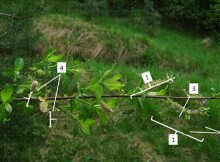VARIANTS OF GENERATIVE SHOOTS OF BOREAL WILLOW SPECIES (SALICACEAE)
- Authors: Nedoseko O.I.1, Kostina M.V.2,3, Leonova N.A.4,5
-
Affiliations:
- National Research Nizhny Novgorod Lobachevsky State University, Arzamas Branch
- Sevastopol State University
- Moscow Pedagogical State University
- Penza State University
- State Nature Reserve “Volga Forest-Steppe”
- Issue: No 1 (2025)
- Pages: 1-16
- Section: Articles
- URL: https://journal-vniispk.ru/2500-0578/article/view/290023
- DOI: https://doi.org/10.21685/2500-0578-2025-1-4
- ID: 290023
Cite item
Full Text
Abstract
The structural and functional organization and dynamics of the development of generative shoots in boreal willow species have not been sufficiently studied yet, which determined the aim of the study. The structure of spring generative shoots of regular renewal and summer secondary flowering generative shoots was examined in 16 species of boreal willows. Attention was paid to the time of the appearance of generative shoots, the length, the degree of vegetation and the duration of the vegetative zone. In S. myrsinifolia, the location of male and female flowers in bisexual inflorescences and the location of generative shoots (male, female, and bisexual) in the plan shoot system were revealed. The study found that the examined willow species can develop, in addition to generative shoots of regular renewal, secondary flowering generative shoots. Generative shoots of regular renewal are divided into single-stage falling (S. caprea, S. vinogradovii, S. gmelinii, S. acutifolia, S. viminalis, S. aurita, S. lapponum), two-stage falling (S. alba, S. euxina, S. triandra, S. cinerea, S. myrsinifolia, S. starkeana, S. rosmarinifolia, S. myrtilloides) and conditionally non-matching (S. pentandra). Among the secondary flowering generative shoots, 5 variants were identified, differing in the length and variety of the vegetative zone. Secondary flowering generative shoots can be divided into summer and late summer shoots according to the time of appearance. In the same species, generative shoots of regular renewal and secondary flowering generative shoots may differ in the structure of the vegetative zone. In S. myrsinifolia, male, female, and bisexual inflorescences can form on the same plant, while generative shoots with male inflorescences develop from both wintering buds and dormant buds. Polymorphism of generative willow shoots is determined by the degree of vegetation and duration of the vegetative zone, the time of formation of generative shoots, the formation of not only unisexual, but also bisexual inflorescences.
About the authors
O. I. Nedoseko
National Research Nizhny Novgorod Lobachevsky State University, Arzamas Branch
Author for correspondence.
Email: nedoseko@bk.ru
Arzamas, Russia
M. V. Kostina
Sevastopol State University; Moscow Pedagogical State University
Email: mv.kostina@mpgu.su
Sevastopol, Russia; Moscow, Russia
N. A. Leonova
Penza State University; State Nature Reserve “Volga Forest-Steppe”
Email: na_leonova@mail.ru
Penza, Russia; Penza, Russia
References
- Skvortsov A.K. Ivy SSSR (sistematicheskiy i geograficheskiy obzor) = Willows of the USSR (systematic and geographical review). Moscow: Nauka, 1968:255. (In Russ.)
- Belyaeva I.V., Epanchintseva O.V., Shatalina A.A., Semkina L.A. Ivy Urala: atlas-opredelitel = Willows of the Urals: atlas-identifier. Ekaterinburg: UrO RAN, 2006:173. (In Russ.)
- Kostina M.V. Nature of bud scales in the Salicaceae family. Botanicheskiy zhurnal = Botanical Journal. 2012;97(5):583–592. (In Russ.)
- Serebryakov I.G. Morfologiya vegetativnykh organov vysshikh rasteniy = Morphology of vegetative organs of higher plants. Moscow: Sovetskaya nauka, 1952:391. (In Russ.)
- Kostina M.V., Barabanshchikova N.S., Nedoseko O.I., Yasinskaya O.I. Features of the constructive organization of trees in the temperate zone, determined by the structure and rhythm of development of generative shoots. Botanicheskiy zhurnal = Botanical Journal. 2022;107(7):627–651. (In Russ.)
- Kostina M.V. Generative shoots of woody angiosperms of the temperate zone: PhD abstract. Moscow, 2009:40. (In Russ.)
- Nedoseko O.I. Formation of life forms and crown architectonics of boreal willow species of the subgenera Salix and Vetrix Dumort. in ontogenesis: DSc dissertation. 2018:710. (In Russ.)
- Aksenova N.P., Bavrina T.V., Konstantinova T.I. Tsvetenie i ego fotoperiodicheskaya regulyatsiya = Flowering and its photoperiodic regulation. Moscow: Nauka, 1973:294. (In Russ.)
- Levy Y.Y., Dean C. The transition to flowering. Pl. Cell. 1998;10:1973–1985.
- Zhmylev P.Yu., Karpukhina E.A., Zhmylev A.P. Secondary flowering: induction and developmental disorders. Zhurnal obshchey biologii = Journal of General Biology. 2009;70(3):262–272. (In Russ.)
- Linne C. Species plantarum. 2 ed. Holmiae, 1763:1019–1022.
- Velenovsky M. Vergleichende Studien uber der Salix-Blute. Beih. 1904;(Bot. Gentrbl. Bd. 17):123–128.
- Fischer M.J. Themorphology and anatomy of the flovers of the Salicaceae. Amer. J. Bot. 1928;15:308–313.
- Malyutina E.T. On hermaphroditism in willows of the section Vetrix. Lesnoy zhurnal = Forestry Journal. 1973;1: 1–9. (In Russ.)
- Malyutina E.T. On the causes of sex change in Salix triandra f. Guadrivalvis. Byulleten GBS AN SSSR = Bulletin of the Main Botanical Garden of the USSR Academy of Sciences. 1973;(88):59–61. (In Russ.)
- Malyutina E.T. Some additional information on androgyny in willows. Nauchnye doklady vysshey shkoly. Biologicheskie nauki = Scientific reports of higher education. Biological sciences. 1974;(2):66–72. (In Russ.)
- Nedoseko O.I. Monoecious individual of blackening willow. Estestvennye i gumanitarnye nauki – ustoychivomu razvitiyu obshchestva: Mezhdunar. sb. nauch. tr., posvyashch. godu Germanii v Rossii = Natural sciences and humanities for sustainable development of society: International collection of scientific papers dedicated to the year of Germany in Russia. Alteks, 2012:110–114. (In Russ.)
- Kardo-Sysoeva E.N. On gynandromorphism in Salix cinerea L.. Trudy Leningradskogo obshchestva estestvoispytateley = Proceedings of the Leningrad Society of Naturalists. 1924;54(3):41–44. (In Russ.)
- Samusev F.F. Monoecious goat willow. Botanicheskiy zhurnal = Botanical Journal. 1961;46(6):896–897. (In Russ.)
- Valyagina-Malyutina E.T. Ivy evropeyskoy chasti Rossii = Willows in the European part of Russia. Moscow: Tovarishchestvo nauchnykh izdaniy KMK, 2004:217. (In Russ.)
- Gribova S.A., Isachenko T.I., Lavrenko E.M. (eds.). Rastitelnost Evropeyskoy chasti SSSR = Vegetation in the European part of the USSR. Leningrad: Nauka, 1980:429. (In Russ.)
- Troll W. Praktische Einführung in die Pflanzenmorphologie, Erster Teil: Der vegetative Aufbau. Jena: Gustav Fischer, 1954:258.
Supplementary files
























